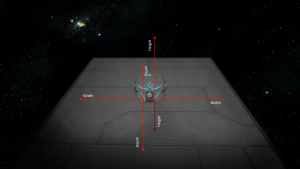Gravity Generator


Gravity block information is listed in the table down below.
| Components | Required |
| Steel Plate | 40 |
| Functional | |
| Computer | 40 |
| Hack | |
| Motor | 6 |
| Large Steel Tube | 4 |
| Steel Plate | 56 |
| Construction Component | 60 |
| Gravity Generator Components | 6 |
| Steel Plate | 54 |
| Info | |
| Dimensions (W,H,L) | 1,1,1 |
| Mass | 8,532 kg |
| Integrity | 20,320 |
| Build Time | 50 s |
| Max Field Size | 150,150,150 |
| Max Gravity Acceleration | 9.81 m/s² |
| Max Required Input | 567.13 kW |
| Power Consumer Group | Utility |
| Is Airtight | No |
| PCU Cost | 185 |
| Components | Required |
| Steel Plate | |
| Functional | |
| Computer | |
| Hack | |
| Motor | |
| Large Steel Tube | |
| Steel Plate | |
| Construction Component | |
| Gravity Generator Components | |
| Steel Plate | |
| Info | |
| Dimensions (W,H,L) | |
| Mass | |
| Integrity | |
| Build Time | |
| Max Field Size | |
| Max Gravity Acceleration | |
| Max Required Input | |
| Power Consumer Group | |
| Is Airtight | |
| PCU Cost | |
Overview
A Gravity Generator is a device used to create artificial gravity. It may only be placed on largeshipsp or station building blocks. The orientation of the gravity generator dictates the direction of gravity, with the side of the block that the gravity generator is installed on becoming “down”, and the side with the control panel and the opposite one becoming the “depth” axis, relative to the gravity generator. Multiple generators will act together, increasing force significantly, and multiple generators at different angles will all play a roleinn the direction gravity affects the player, objects, and Artificial Mass Blocks.
Usage
The gravitational acceleration can be configured using a slider, with possible values being between -1G and 1G. By adjusting the depth, height, and width sliders accordingly, the shape of the gravitational field can be altered to be any variation of a rectangular prism, whether cubic, flat, tall, wide, narrow, short, or long.
Note that in Survival Mode, the larger the effective volume of the gravitational field and the acceleration force, the more power consumption the gravity generator will use. Considerable energy can be saved over time by carefully placing the gravity generator in a more central location and then adjusting the field to affect a smaller area.
Considered alternatives and usage information is available on Marek Rosa’s development blog
Terminal

Grav Generator with the dimensions of the gravity field shown.
Artificial Gravity can also be configured to affect the shape of the gravitational field. The maximum effective depth, height, and width are 150 meters centered on the gravity generator or 75 meters in all directions.
- Depth – The distance “behind” and “in front of” the keypad of the gravity generator.
- Height – The distance “above” and “below” the gravity generator.
- Width – The distance “left” and “right” of the gravity generator.
Power requirements
The primary factors involved in calculating the power requirement of each generator are Gravitational Acceleration which provides (a number between 0 to 9.81) the volume of the field that is being generated which is a function of its dimensions (width, height, and depth). This is then raised to the power of a constant as follows:
Power Requirement (MW) = 0.0003 x absolute gravitational acceleration x volume of the field (w x d x h) ^ 0.35
So a field that is only a 50-meter cube, can be calculated to require:
0.0003 x 9.81 x 125000^0.35 = 178.94 KW
Effectiveness in Natural Gravity
Planets and Moons by default have their natural gravitational fields. While it is possible to use gravity generators in the presence of Natural Gravity, its effectiveness diminishes the higher the natural gravitational force is. It reaches a point where Artificial Gravity has no measurable/noticeable effect. The formula for its effectiveness is as follows:
Ag – Artificial Gravity set in Gravity Generator
Ng – Natural Gravity in [G] units – [0, 1]
Max – higher of 2 values
effective Artificial Gravity = Ag * Max(1 – 2*Ng, 0)
For example, at 0.25G of Natural Gravity acceleration from a single Gravity Generator set to 0.8G the effective acceleration is 0.4G, which is 3.9 m/s^2. At 0.5G or 1G of Natural Gravity acceleration from a Gravity, Generator is 0 m/s^2 regardless of the setting. No matter how many Gravity Generators are used they are essentially just drawing power for nothing.
